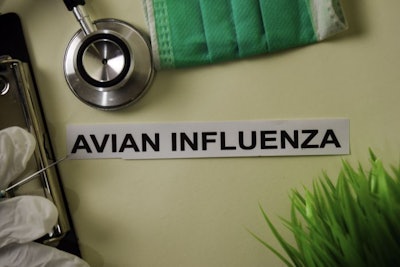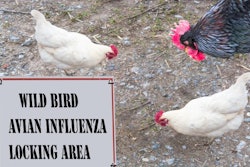
Following the detection of H5N8 highly pathogenic avian influenza (HPAI) virus in wild birds since October, South Korea has confirmed its first cases in poultry for this season.
At the end of November, the first HPAI outbreak on a poultry farm occurred at Jeongeup in North Jeolla province. According to Yonhap news agency, 400,000 poultry were culled to halt the spread of infection.
The same source reports a second confirmed outbreak, this time at Sangju in North Geongsang province. Around 208,000 chickens and quail will be culled at this premises. Furthermore, authorities are closely monitoring a further 251,000 poultry on farms within 3 kilometers of the infected premises.
H5N8 HPAI virus has also been detected in wild ducks at a further three locations in South Korea, reports the agriculture ministry. According to the official report to the OIE, these included two locations in the northern province of Gyeonggi, and one on the resort island of Jeju.
Japan confirms 10th HPAI outbreak
Over the past week, avian flu virus has been detected at three more poultry farms in Japan, reports Nippon.com. These bring the country’s total for this season to 10 in four prefectures.
Affected are a farm in one of Japan’s most important poultry producing regions, Miyazaki prefecture. Here, 40,000 poultry will be culled after an H5 virus was detected. Pathogenicity is still to be confirmed. A similar virus has been found at two more chicken farms in Mitoyo city in Kagawa prefecture. There has also been one outbreak in each of the prefectures of Fukuoka and Hyogo.
Overview of HPAI in European poultry flocks: first cases of the winter
So far in this winter season, HPAI has been detected in nine European countries, according to the Animal Disease Notification System of the European Commission (EC).
In its latest update to November 29, 22 outbreaks in poultry have been registered over the previous two weeks. These include the first outbreaks of this winter season in Belgium, Croatia, Denmark, France, and Sweden.
Recording additional cases over this period are Germany (6), The Netherlands (2), and one each in Poland and the United Kingdom (U.K.)
First cases in Belgium were detected at a farm in Menen in West Flanders, reports the national agency for safety in the food chain, FASFC. Presence of the H5N5 virus variant was confirmed in a flocks of 151,600 broilers. Around 600 of the birds died. Last detection of this virus in the country was in June of 2017.
In France, the number of outbreaks in captive birds now stands at eight, according to the European Reference Lab for avian influenza, IZSVe. These include poultry in hobby flocks, and ornamental species. On the island of Corsica, six of the latest outbreaks have been linked to the initial outbreak at a pet shop in mid-November. Together with one outbreak at a garden shop in Yvelines — a suburb of Paris — a total of 1,056 birds have been involved.
Details of the outbreaks among poultry in Croatia, Denmark, and Sweden can be found in a previous report.
Following the first outbreak of HPAI in Poland of this winter, the country’s chief veterinary office has reported that Russia had banned imports of all Polish poultry products. In November, the H5N8 virus variant was detected in a flock of around 900,000 laying hens in the province of Greater Poland (Wielkopolskie).
Analysis of the virus isolated in Poland confirms it is closely related to others of the same sub-group currently circulating in Europe, according to the same agency. Furthermore, this variant is not associated with human infections.
Additional cases in poultry in Germany, The Netherlands, United Kingdom
Over the past week, one new outbreak of HPAI has been reported in Germany. According to the national veterinary authority, the Friedrich-Loeffler Institute, the H5N8 virus variant was detected in one goose in Schleswig-Holstein (Dithmarschen municipality), and in a flock of laying hens in Mecklenburg-West Pomerania (Mecklenburgische Seenplatte).
In The Netherlands, the number of HPAI outbreaks has risen to six, directly involving almost 414,000 poultry. Outbreaks have now occurred in four provinces, according to official reports to the World Organisation for Animal Health (OIE).
According to the Dutch agriculture ministry, a hobby poultry flock of around 300 poultry has tested positive for an H5 HPAI virus. The premises is in Utrecht province (Mijdrecht in De Ronde Venen municipality). There are no nearby poultry flocks, and just one with 10 kilometers of the affected farm.
In England, the agriculture department (Defra) has confirmed a further outbreak of HPAI in poultry. This involved a flock of meat turkeys at Northallerton in North Yorkshire. Another outbreak in the same area is suspected.
So far this season, six HPAI outbreaks linked to the H5N8 virus subtype have been confirmed in the United Kingdom (U.K.). In early November, there has also been a single outbreak in which a low-pathogenic avian influenza (LPAI) has been detected.
Previously, the IZSVe reported the detection of a low-pathogenic avian influenza (LPAI) virus at a farm in Italy for the first time since June. The virus has now been identified as an H5N2 variant. Without symptoms or elevated mortality, routine testing revealed a number of cases in broilers and ducks at a farm in Pavia (Lombardy region).
Changes to HPAI restrictions
As a result of the ongoing threat of avian flu in Europe, the veterinary authorities of Northern Ireland (DAERA) and the Republic of Ireland (DAFM) have introduced respective nationwide Avian Influenza Prevention Zones (AIPZ) over the past week.
With immediate effect, this places a legal requirement on all bird keepers to follow strict biosecurity measures. These include a ban on bird gatherings. Feed and water must be provided for poultry while excluding wild species. Movements of people, equipment, and vehicles are to be minimized, and cleaning and disinfection are required. For the time being, there is no requirement for poultry to be kept housed.
In Demark, the Veterinary and Food Administration has lifted some of the restrictions introduced after the country’s first cases of HPAI. Captive pigeons and birds of prey can now be flown free for short periods of exercise.
Europe: first indications of HPAI among wild birds in Italy, Norway, Spain
A first ever case of HPAI linked to the H5N8 virus variant has been registered in Norway. It was detected in a wild goose found dead in the southwestern county of Rogaland, according to the agriculture ministry’s latest notification to the OIE.
Also registering a first HPAI case in the wild bird population is Spain. According to the agriculture ministry, the same virus subtype was found recently in a wild bird in the northern region of Cantabria.
In Italy, 12 wild birds hunted in the Veneto region have tested positive for HPAI, reports IZSVe. H5N8 variant was detected in eight of the birds, and H5N5 in the other four.
For the first time in two years, the H5N5 HPAI virus has been detected in wild birds in The Netherlands. Two geese found dead in North Brabant during November have tested positive for this virus subtype, according to the official OIE report.
General HPAI situation in European wild, captive birds
So far this winter season, 11 European countries have confirmed one or more cases of HPAI in wild birds, according to the EC.
For the whole of 2020 up to November 29, there have been 460 outbreaks. This is an increase of 206 over the previous two weeks. With 335 outbreaks, Germany has been worst affected, and its total has risen by 131 over this period.
Also reporting through this system are Denmark (51 outbreaks so far this year), The Netherlands (42), U.K. (10), Belgium (7), and Ireland (5). Italy, Norway, Slovenia, Spain, and Sweden have each registered up to three HPAI outbreaks in wild birds so far this year.
Over the past week, Germany’s agriculture ministry has reported detecting the H5N8 HPAI virus in wild birds at 15 locations — in Mecklenburg West-Pomerania, Lower Saxony, Hamburg city, Brandenburg, and North Rhine-Westphalia. This variant was also detected for the first time this winter in Saxony. Meanwhile, the H5N5 variant was found for the first time in Lower Saxony, along with more cases in Mecklenburg-West Pomerania and Schleswig-Holstein.
A second wild swan found dead on the coast of Slovenia has tested positive for the avian flu virus, according to the STA news agency.
Among captive birds in European countries, 10 HPAI outbreaks have been registered with the EC so far this year. Of these, six were in The Netherlands, and one in the U.K. during November. Cases have also been recorded in Germany and Slovakia, but not since March.
HPAI detected in Iranian wild birds
According to the Iran Veterinary Organization, the H5N8 HPAI virus has been detected in wild birds at two locations in the country.
Affected have been wild geese at a national park in Markazi in the west of the country, and swans in the northwestern region of Ardebil. These locations are on flyways used by migratory birds, and contact with wild species is thought to be the source of infection, according to the official report to the OIE.
View our continuing coverage of the global avian influenza situation.
















